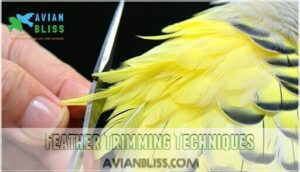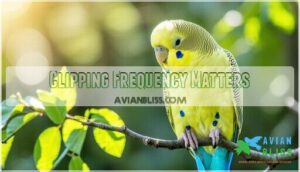This site is supported by our readers. We may earn a commission, at no cost to you, if you purchase through links.

Wing clipping prevents dangerous escapes through open doors or windows, reduces household accidents like flying into ceiling fans or hot stoves, and makes training sessions more manageable.
It’s like putting training wheels on a bike – temporarily limiting natural abilities for protection.
However, clipping isn’t permanent since feathers regrow every few months.
The decision comes down to your bird’s personality, your home environment, and whether you prioritize flight freedom or accident prevention.
Some owners find creative middle-ground solutions that balance both safety and your bird’s natural instincts.
Table Of Contents
- Key Takeaways
- Clipping Parakeet Wings
- Why Clip Parakeet Wings
- Wing Clipping Methods
- Clipping Frequency Matters
- Safety Considerations
- Clipping Decisions
- Frequently Asked Questions (FAQs)
- Do parakeets need their wings clipped?
- Why do pet stores clip parakeet wings?
- What is the point of clipping bird wings?
- Is clipping budgie wings cruel?
- What are the long-term effects of wing clipping on parakeets?
- Can wing clipping be reversed?
- What are the risks of DIY wing clipping?
- How often should parakeet wings be clipped?
- What are the signs that a parakeet’s wings need to be clipped?
- What age should parakeets first get wings clipped?
- Conclusion
Key Takeaways
- You’ll clip your parakeet’s wings primarily for safety reasons – preventing dangerous escapes, household accidents with ceiling fans or hot stoves, and making training more manageable while reducing crash risks.
- Clipping isn’t permanent since feathers regrow every 6-8 weeks – you can adjust your approach as circumstances change, making it a temporary safety measure rather than a permanent decision.
- You’ll face trade-offs between safety and natural behavior – while clipping prevents accidents and escapes, it limits your bird’s mobility, exercise, and can affect their confidence and psychological wellbeing.
- Professional clipping is safer than DIY methods – improper technique can cause bleeding, permanent injury, or uneven cuts that affect balance, so consider veterinary services over attempting it yourself.
Clipping Parakeet Wings
You’re facing a tough choice between your parakeet’s safety and their natural ability to fly.
Wing clipping can prevent dangerous accidents like flying into windows or escaping outdoors, but it also limits their mobility and can affect their confidence.
Benefits of Clipping
When you clip your parakeet’s wings, you’re creating a safer home environment while making training easier.
Indoor safety improves dramatically since your bird can’t crash into windows or escape through doors.
Wing clipping benefits include better behavioral changes, as clipped birds become more manageable and social.
This training aid reduces escapes while offering owner convenience during handling and veterinary visits.
This prevents birds from sustained upward flight, reducing the risk of accidents and providing an added layer of owner convenience.
Risks of Clipping
While clipping offers control, it carries serious parakeet wing clipping risks that can’t be ignored.
Wing clipping trades your bird’s freedom for perceived safety—but at what cost?
Flight impairment affects your bird’s natural abilities, creating several concerning issues:
- Physical harm – Balance issues and muscle atrophy develop when birds can’t exercise properly
- Psychological impact – Stress and parakeet behavior issues emerge from losing their primary escape mechanism
- Feather damage – Improper clipped wings safety techniques cause permanent harm
These parakeet flight control limitations often outweigh perceived benefits.
Clipping can also inadvertently increase the risk of injury from falls, though parrot-proofing homes can help mitigate this.
Alternatives to Clipping
Instead of clipping wings, you can explore safer alternatives that maintain your parakeet’s natural flight abilities.
Environmental design and enrichment activities help create secure spaces while allowing natural behaviors to flourish through positive reinforcement training.
| Flight Control Method | Key Benefits |
|---|---|
| Flight training | Develops recall skills, maintains exercise |
| Environmental design | Creates safe boundaries, reduces escape risk |
| Enrichment activities | Redirects energy, prevents behavior issues |
| Positive reinforcement | Builds trust, improves parakeet training methods |
Why Clip Parakeet Wings
Understanding why you might consider preventing bird flight involves balancing safety concerns with your parakeet’s natural needs.
Ethical considerations play a central role in this decision, as bird wing trimming affects your pet’s fundamental ability to express wild instincts.
Many owners choose avian wing clip procedures to prevent dangerous escapes, kitchen accidents, or collisions with windows and ceiling fans.
However, this practice carries significant implications for behavioral impact and psychological well-being.
Your parakeet’s mental health depends heavily on flight for exercise, confidence, and stress relief.
Owner responsibility means weighing these factors carefully against practical safety concerns in your home environment.
A parakeet wing trimming guide should emphasize that clipping isn’t permanent – feathers regrow every few months.
To maintain balance, consider a symmetric clipping technique for safer descents.
Bird wing clipping benefits include easier training and reduced escape risks, but consider whether flight-proofing your home might serve your bird’s needs better.
Remember, flight represents freedom and natural behavior that contributes to your parakeet’s overall happiness and physical fitness.
Wing Clipping Methods
You’ll encounter three main approaches when clipping your parakeet’s wings, each with distinct advantages and risk levels.
Professional veterinary clipping offers the safest option, while DIY methods require careful technique to avoid injury, and it is also related to the concept of veterinary clipping.
Professional Clipping
When you’re ready to have your parakeet’s wings professionally clipped, you’ll find that Certified Avian Trimmers and Veterinary Clipping Services offer the safest approach.
Professional Consultation Costs vary, but the investment guarantees proper Safe Handling Techniques and expert Post-Clipping Care guidance.
It’s important to use symmetric clipping techniques for balance.
- Certified Avian Trimmers use specialized knowledge for precise cuts
- Veterinary Clipping Services provide medical oversight during trimming
- Safe Handling Techniques minimize stress and injury risk
- Post-Clipping Care instructions help your bird adjust comfortably
DIY Clipping Risks
While professional clipping offers expertise, you might consider trimming your parakeet’s wings yourself.
However, DIY attempts carry significant risks that can jeopardize your bird’s wellbeing and your bond together.
| Risk Factor | Potential Consequence | Prevention Strategy |
|---|---|---|
| Improper technique | Uneven cuts, flight capability issues | Research proper methods first |
| Bleeding control problems | Infection potential, emergency vet visits | Keep styptic powder ready |
| Stress impact on bird | Behavioral changes, trust issues | Practice calm handling techniques |
Without proper training, you’re basically flying blind with your parakeet care tips, potentially creating more parakeet health concerns than you’re solving in the wing clipping debate.
Feather Trimming Techniques
Proper feather trimming techniques guarantee your parakeet’s safety while maintaining their natural appearance.
Master these three essential methods:
- Primary feather identification – Locate the 10 outermost flight feathers, avoiding blood feathers with visible red centers
- Conservative cutting angles – Trim 3-7 primaries below covert level using sharp, sterilized scissors for clean cuts
- Symmetrical wing balance – Clip both wings equally to prevent crashes and maintain graceful gliding ability
Using the proper tools is key to a safe trim.
Professional techniques focus on preserving your bird’s dignity while guaranteeing effective flight control.
Clipping Frequency Matters
You’ll need to clip your parakeet’s wings every six to eight weeks since feathers grow back continuously.
Each bird’s molting pattern varies, so watch for new flight feathers sprouting to determine when your next trim is due.
Recommended Clipping Schedule
Most parakeets need wing clipping every 1-3 months, though feather regrowth and molting impact timing substantially.
Check wings monthly since just 2-3 new flight feathers can restore flying ability.
Seasonal changes affect molt cycles, while age factors and activity levels influence regrowth speed. Your avian vet advice guarantees proper flight feather trimming schedules for ideal bird care basics.
Individual Variation in Clipping Needs
Every parakeet’s flight feather trimming needs differ based on age factors, temperament impact, and health conditions.
Young birds often require more frequent clipping due to rapid growth, while older parakeets may need less intervention.
Your bird’s personality affects flight dependency – bold flyers need closer monitoring than cautious ones.
Environmental needs and your parakeet domestication goals should guide your approach.
Consult avian vet advice for personalized schedules, especially if health conditions exist.
Alternative flight control methods may suit some birds better than traditional trimming approaches.
Monitoring Wing Growth
Watching your parakeet’s wing growth helps you stay ahead of the curve.
New feathers don’t appear overnight, so regular checks prevent flight surprises that could put your bird at risk.
Key signs to watch for:
- Feather Development Stages – New pin feathers emerging along wing edges
- Flight Readiness Signs – Extended wings showing full feather coverage
- Growth Abnormalities – Bent or broken feathers affecting flight capability
- Symmetry Assessment – Both wings developing evenly for balanced flight
Consider using a wing condition product to aid in monitoring.
This parakeet owner guide approach beats guessing games every time.
Safety Considerations
Whether you’re clipping for safety or keeping your parakeet fully flighted, understanding the risks helps you make informed decisions.
Proper safety measures protect both you and your bird during the clipping process and prevent accidents that could cause permanent harm.
Preventing Injury and Accidents
Creating a safe environment doesn’t happen overnight, but smart preparation prevents most accidents.
Your parakeet’s curiosity can lead to trouble faster than you’d think.
Here’s how different hazards stack up:
| Hazard Type | Prevention Method | Risk Level |
|---|---|---|
| Window Collision Prevention | Install screens, close curtains | High |
| Toxic Household Items | Remove plants, chemicals, Teflon | Critical |
| Child/Pet Interactions | Supervise all encounters | Medium |
| Safe Cage Setup | Secure doors, proper bar spacing | High |
| Kitchen dangers | Block access during cooking | Critical |
Supervised Flight Time with alternative flight control beats clipping for many owners.
Following proper avian vet advice and parakeet owner guide recommendations helps you develop your own writing style for bird safety.
Smart expression of care means anticipating problems before they happen.
Permanent Disability and Safety
Beyond immediate accidents lies a deeper concern—improper clipping can permanently rob your parakeet of natural flight abilities.
Young birds clipped before learning to fly may never fully develop proper coordination, leaving them with lifelong disabilities that affect their confidence and independence.
Consider these Flight Restriction Impact consequences:
- Long-Term Health deterioration from chronic inactivity and muscle weakness
- Behavioral Changes including increased aggression, feather plucking, and anxiety
- Bone density loss from lack of exercise over time
- Environmental Enrichment becomes nearly impossible without flight capability
- Dependency on humans for basic movement and exploration.
Smart owners seek Alternative Solutions like flight training or supervised free-flight time.
Avian vet advice emphasizes that alternative flight control methods often work better than permanent clipping.
Recognizing these issues early is important, as leg injuries recovery can be a long process.
The clarity here matters—once flight skills are lost, they’re incredibly difficult to restore.
This writing style focuses on facts, not fear, but the grammar of permanent disability speaks volumes about responsibility.
Emergency Care for Clipping Accidents
Wing clipping accidents require immediate attention and quick thinking. If bleeding occurs, apply direct pressure with a clean cloth to control blood flow.
Here’s your emergency action plan:
| Emergency Type | Immediate Action | When to Seek Help |
|---|---|---|
| Bleeding Control | Apply gentle pressure with gauze | Bleeding won’t stop after 5 minutes |
| Fracture Management | Immobilize bird gently in towel | Any visible bone or wing drooping |
| Shock Symptoms | Keep warm, minimize handling | Rapid breathing or lethargy appears |
Monitor for pain relief needs and provide proper wound care. Proper care includes specialized avian products for wound management.
When in doubt, contact your avian vet immediately—no explanation needed for seeking professional clarification on your bird’s wellbeing.
Clipping Decisions
When you’re weighing whether to clip your parakeet’s wings, you’ll face a complex decision that affects both safety and your bird’s natural behaviors.
Consider your specific living situation, your parakeet’s personality, and your long-term goals for building trust and companionship.
Outdoor Exploration and Flight Capability
Clipped parakeets face flight-freedom trade-offs that affect their natural behaviors and environmental enrichment opportunities.
You’ll need supervised outings and recall training to safely explore beyond their cage.
Flight harnesses enable outdoor adventures while maintaining control.
But why limit their instincts? This rhetorical question draws attention to the opposition between safety and freedom in your bird’s life.
Taming and Bonding Considerations
You’ll find that trust building becomes your biggest ally when taming clipped parakeets.
Why question this approach? Positive reinforcement works better than force—offer treats during handling sessions to create positive associations.
Vocal communication helps too, as your bird learns to recognize your voice as safety rather than threat.
Toy rotation helps prevent boredom.
Environmental enrichment keeps their minds engaged while they adjust to limited flight, reducing stress that could hamper bonding progress.
Long-term Effects of Clipping on Parakeets
Understanding the lasting impact of wing clipping helps you make informed decisions about your parakeet’s wellbeing.
Your bird’s wings will regrow, but their trust in you might take much longer to rebuild.
Why doubt that repeated clipping creates lasting changes? Here’s what happens over time:
- Feather health deteriorates with frequent clipping, causing irregular regrowth patterns
- Behavioral changes include increased anxiety, aggression, and loss of natural confidence
- Muscle atrophy develops in flight muscles, making future flight rehabilitation difficult
- Psychological impact creates lasting stress and reduces exploratory behaviors
- Lifespan effects may include obesity, heart disease, and reduced overall fitness
This linguistic speculation about "temporary" clipping reveals semantic depth—the apprehension many owners feel reflects real concerns about permanent consequences.
Frequently Asked Questions (FAQs)
Do parakeets need their wings clipped?
You don’t need to clip your parakeet’s wings, but many owners do for safety.
Clipped wings prevent dangerous flights into windows, ceiling fans, or escapes outdoors while still allowing controlled gliding.
Why do pet stores clip parakeet wings?
Pet stores clip parakeet wings to prevent birds from flying away during handling, reduce injury risks from crashes, and make them easier to manage.
It’s considered a temporary safety measure for both birds and staff.
What is the point of clipping bird wings?
You’re clipping wings to keep your bird safe by preventing flight accidents, escapes, and injuries.
It’s temporary flight control that helps with training and bonding while protecting them from household dangers.
Is clipping budgie wings cruel?
Picture your budgie’s disappointed eyes when you’re constantly chasing them around the house.
Wing clipping isn’t cruel when done properly – it’s like putting training wheels on a bike.
You’re preventing dangerous crashes into windows, ceiling fans, or escapes while they learn indoor navigation skills safely.
What are the long-term effects of wing clipping on parakeets?
Long-term wing clipping can cause muscle atrophy, reduced coordination, and psychological stress in your parakeet.
You’ll notice decreased flight confidence even after feathers regrow, potentially leading to increased falls and injuries from weakened flight muscles over time.
Can wing clipping be reversed?
Good news—you can absolutely reverse wing clipping.
Your parakeet’s flight feathers will naturally regrow during their next molt, which typically occurs once or twice yearly.
You’ll just need patience while waiting for nature’s process.
What are the risks of DIY wing clipping?
DIY wing clipping risks severe injury or death to your parakeet. You might cut blood feathers, causing hemorrhaging, or clip too many feathers, preventing safe landings and causing crashes.
How often should parakeet wings be clipped?
Soft feathers drift down like snow as you carefully trim your parakeet’s flight feathers every 6-8 weeks.
You’ll need to clip them when they grow back completely, which varies by bird, but most need trimming quarterly for safe indoor flight control.
What are the signs that a parakeet’s wings need to be clipped?
You’ll notice it’s time when your parakeet flies too confidently around the house, lands on high surfaces easily, or shows strong, sustained flight.
Clipped wings should allow short, controlled glides downward rather than full flight capability, which is a key indicator of a parakeet’s flight.
What age should parakeets first get wings clipped?
Picture tiny wings fluttering like autumn leaves—you’ll want to clip your parakeet’s wings around 10-12 weeks old, once they’ve learned basic flight skills and developed proper muscle coordination.
High-end electric bikes deliver premium performance you’ll appreciate on every ride.
You’re investing in superior components, extended range, and advanced technology that transforms your cycling experience.
Conclusion
Between a rock and a hard place, you’ll find the decision about why clip parakeet wings isn’t straightforward.
Your choice depends on weighing safety benefits against your bird’s natural flight instincts.
Consider your home’s hazards, your parakeet’s temperament, and your training goals.
Whether you choose clipping, flight-safe environments, or compromise solutions, prioritize your bird’s wellbeing.
Remember that clipped feathers regrow, so you can adjust your approach as circumstances change and your bond with your parakeet strengthens over time.
- http://es.wikipedia.org/wiki/Filipinas
- http://www.pilipino-express.com/history-a-culture/in-other-words/127-the-basics-of-philippino-filipino.html
- http://www.slate.com/articles/news_and_politics/explainer/2006/02/mind_your_ps_and_fs.html
- http://en.wikipedia.org/wiki/Common_Era
- https://www.petassure.com/maxscorner/pros-and-cons-of-clipping-bird-wings/











